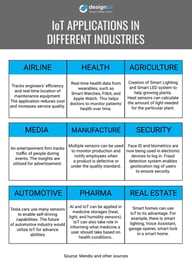The concept of smart cities has been implemented in Singapore, Dubai, and Barcelona. Smart cities typically collect data from the Internet of Things sensors. The city can then analyze the data and utilize it for Artificial Intelligence. For example, the data can be used for predictive analytics or machine learning. IoT sensors can enhance connectivity and increase productivity growth.
Where you can find the applications and how it will improve efficiency
According to McKinsey’s study in 2017, the Internet of Things can generate $4-$11 trillion in economic value by 2025. The key is to enhance the connectivity to improve efficiency. Technology advances will reduce power requirements and decrease costs. McKinsey noted how the price of lidar sensors (laser-based sensors that scan surroundings and are used on autonomous vehicles) had declined more than 10-fold for 8 years.
Many sensors produce data, namely motion sensors, temperature sensors, light sensors, wind sensors, air quality sensors, heat sensors, and more. You can imagine how they are useful in our gadgets and equipment. They exist in mobile phones to smart homes, wind turbines to CCTV for face recognition, from a Tesla car to a medicine storage room, and from earthquake radar to agricultural machinery.
IoT and the future of Artificial Intelligence
In its article, Ericsson mentioned the many industries that need the implementation of IoT: mining, manufacturing, goods transportation, Virtual Reality, and more. Furthermore, Ericsson also discussed security and privacy issues that must be addressed.
With the help of Artificial Intelligence, the Internet of Things could become smarter and more efficient. “While IoT focuses on networks of sensors that generate data… artificial intelligence enables the generation of knowledge and predictability using the valuable data that has been gained,” said the head of Huawei, Wael William Diab.
Read more about Edge AI in our previous blog.
Big companies and what they've done so far
Big tech companies have invested in the Internet of Things. For example, Apple has created iPhones with proximity, motion, ambient light, and moisture sensors. Microsoft created HoloLens for Mixed Reality with an initial measurement unit (IMU), four environment understanding sensors, an energy-efficient depth camera, a 2.4-megapixel photographic video camera, a four-microphone array, and an ambient light sensor. Companies such as Microsoft, Amazon, and ARM have IoT products to offer. In horticulture lighting, Mouser develops Smart LEDs with IoT sensors.
In the healthcare field, Deloitte also offers Internet of Medical Things products. We also see how Apple produced Apple Watch and Google acquired Fitbit. Both systems will have electronic health record systems. Instead of one-time data from a health check-up visit, patients and doctors can monitor health from continuous daily statistics from Apple Watch and Fitbit.
Customer-facing and employee-facing apps
Generating data from IoT sensors is crucial for both customer and employee-facing apps. Let’s look at the healthcare industry. With wearables' help, a patient can know how many calories they burn, how many steps they have walked, their heart rate, etc. The IoT sensors picked up all the data necessary for the customer to evaluate. Meanwhile, from an employee-facing perspective, this data collection will be useful for prescribing medications and alerting when a person is sick.
Another example would be the airline industry. A customer-facing app could tell passengers the boarding time and any changes of gates, the airplane's real-time position, duty-free shop options, etc. Meanwhile, an employee-facing app could show the customers' many inputs (if they request a seat change if they purchase products), fuel efficiency, and other process improvement data to increase revenue.
Well-thought UX-Design for product growth
The key to UX Design is usability, or how to make a design that ‘makes sense to people. As an illustration, a watch with many buttons and functions may look sophisticated. However, users wouldn’t know the buttons’ abilities without reading the instructions. In contrast, a SmartWatch with a good UX design would be easy to control and navigate.
A good design for IoT would be simple and seamless. Imagine a person steps into a smart house. He or she can instruct the house to adjust the light to his liking, turn on the TV with a voice command, choose a movie based on the recommended list, and so on. All this experience should be offered through the same ‘feel.’
Another important part is the process of mining feedback. There would be times when customer experience is bad when you need to evaluate what happened. There should be a clear direction for processing this kind of feedback.
Downturn Effect on IoT platforms and sensors
We always hope for economic growth, but there will be times when it is stagnant or, worse, declining. At this time, technology is always a good investment for businesses. For one thing, technology will always advance: it will be faster, cheaper, and more advanced. Another thing is that technology increases business efficiency.
You can begin investing in technology during a downturn by renting equipment and software. You can also look into Cloud computing from Amazon, Microsoft, Google, and IBM.

Download PDF version
Conclusion
The Internet of Things is the platform of sensors that generates data. Together with Artificial Intelligence algorithms, IoT data can be utilized for predictive analytics, machine learning, NLP, and more.
You can cater to your customer's needs with the right UX Design and UX Research. Contact us for further information.
Editor's note: This post was originally published in October 2020 and has been updated for comprehensiveness.